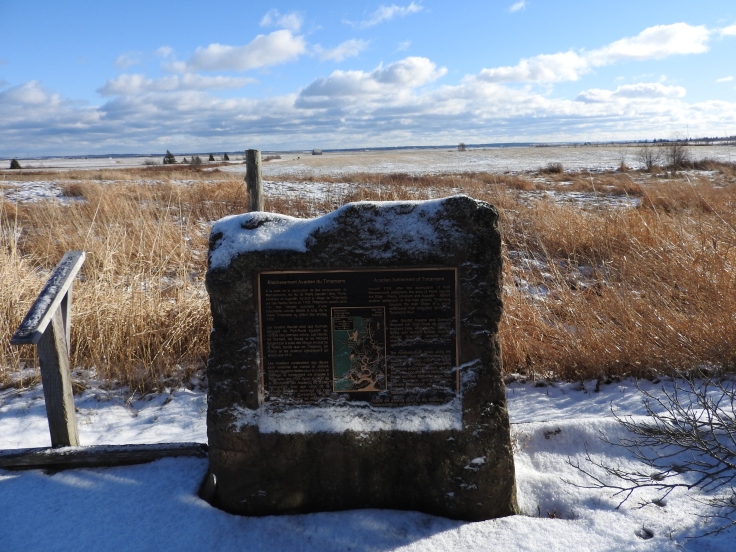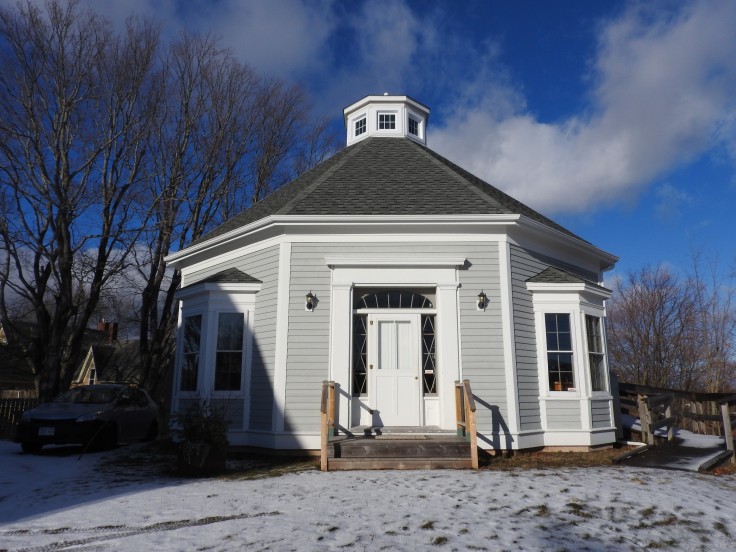The shaggy tops of last summer’s grasses are poking out from the newly fallen snow. I can still sense the important waterfowl habitat of the Tantramar Marsh which surrounds me, but this white coating has changed the landscape to look like every other town in New Brunswick.
I had been here in early June 2016, and I enjoyed a stroll along the boardwalk of the Waterfowl Park. The leaves had just popped out and were a fresh pale green against the white birch. It had been chilly, and the resident ducks were mostly Mallards. On that trip I had qualified Sackville for my Top 20 Maritime Outdoor Escapes, Today I wanted to justify my choice.


I am following a slippery snow-covered road on the outskirts of the town. I blindly follow the directions of my GPS to the Campbell Carriage Factory. It is closed for the winter and while the website states it will open if you make an appointment, I have not done so. I had read it was considered one of the finest examples of 19th-century industry in North America. It was built about 1838 and is a designated national and provincial historic site.
I follow the wooden plank fence to the parking area. Three buildings stand close together: one is the factory, beside it is the carriage storage, and a smaller building at the back is the blacksmith shop.
There is a lovely view of the Tantramar Marsh behind the museum. I am drawn towards the openness, planning to circle the buildings and look for the national historic plaques. However a blast of frigid wind pummels me, so I retreat to the side of the barn for shelter. I will peek in the windows instead. I move along to each window frame jumping up repeatedly to see inside but the windows are too high (or I am too short).
I dash from one sheltered area to the next, landing behind the blacksmith shop. I see no national historic plaques, but I do see a monument at the back of the building. I sweep it clear of snow and ice to read what it says.
The the plaque is titled Arcadians Settle the Tintamarre. It tells a story of three determined brothers, Pierre, Abraham, and Augustine Gaudet, who established a home for themselves here in 1709, after their village in Memramcook, N.B., was destroyed. This led to the settlement of more Acadian folks in the surrounding area. The Acadians were an industrious and resilient people who dug dikes and drained the land to make it useable for growing crops.

The original purchaser of this property was Ronald Campbell. He was a carpenter and a carriage maker by trade with an interesting back story. This factory had been run successfully by several generations of Campbells, until the last two employees were let go and the factory closed it doors for good in 1951. Ronald Campbell occasionally held employment at the Humphrey and Morice Mill, and that is where I am headed to next.
Situated on what is now Silver Lake, all that remains is a mill stone with a plaque recognizing this property as a historical location.
The mill stone says:
Morice Mills 1821-1939 This site was likely a mill and mill dam built by Acadians in the mid 1700s. English settlers from New England established a grist mill and sawmill here in 1764. A succession of partners operated the mill until 1821, when John Morice, a recent arrival from Scotland, acquired a controlling interest and eventually purchased full title to the mills, mill-dam and mill-pond. The Morice family operated the mills which consisted of a sawmill, carding mill and grist mill, for over 100 years. The millstone to which this plaque is attached came from the grist mill that was located just south of this monument. A large woodworking factory was also part of the mills, where windows, doors, furniture and wooden boxes were made. After several replacements the old mill dam finally gave way in 1942. And a new concrete dam was built by the Sackville Fish and Game Association in 1952 to re-establish what is known today as Silver Lake. Lilla Fawcett Park was established by the rotary club of Sackville in 1977 and is owned and maintained by the town of Sackville.
It is too cold for me to stay for long, so I head back into the heart of town. I completely miss the Hammond House, another national historic site, but I am running low on time so continue on to the Sackville Harness Shop. You can read about it in Searching around Sackville, New Brunswick Part 1
Next up is the Boultenhouse, New Brunswick’s only shipwright’s residence, now a museum. It was open till 2 pm and I missed it. Darn. I snap off a few pictures to add to my collection of national historic sites and dash back to my vehicle.

The title of the plaque says The SACKVILLE SHIP BUILDING ERA, it is far to long for me to recite to you, believe me. I will have to return to view the three buildings that are part of the museum when I have more time.
Sackville also has a historic railway station for you railway enthusiasts.
I will be doing a story on railway stations and trains soon. If you can’t wait until then, my good friends at My New Brunswick have an excellent blog post on Sackville Railway Station. I think you will enjoy it.
I will continue out of town and make one more stop at Fort Beauséjour – Fort Cumberland. I have been here several times but I was missing a plaque for Tonge’s Island, the seventeeth-century capital of Acadia and another national historic site to add to my collection.

The plaque reads:
Once Capital of Acadia, situated between Fort Beauséjour and Fort Lawrence. Granted to Michel LeNeuf De La Valliere Seigneur of Chignecto, 1676. There he acted as commandant and Governor under Count De Frontanac from 1678-1684
You can read more on Fort Lawrence in A Return to Amherst, old versus new. and Make Any Drive A Road Trip.
I am a bit disappointed in this adventure — the weather was cold and I had so little time. I wanted to visit Hammond House, the Colville House, and The Owen Art Gallery, which is Canada’s oldest university art gallery. I still haven’t seen the Kath Rutherford Mosaic that graces the entrance to the town hall and I wanted to get to the Tantramar marsh wildlife area.
I rarely miss a good cemetery and the Sackville Rural Cemetery has two important Canadian figures: Henry C.G. Ketchum, the designer and builder of the Chignecto Railway shipping line; and Rt. Hon. Dr. George Stanley, who was the designer of the Canadian Maple Leaf Flag.
I had hoped to hike or snowshoe part of the trail that leaves here and ends at the footbridge in Port Elgin. (I covered that end of the trail in my story Bridges To Cross, 2017 New Brunswick. )
I think I validated why I chose Sackville on my 20 best list. I could easily spend a week here but my winter afternoon will have to do.
Until next time, cheers and happy travels from Maritime Mac.

Contribute
If you like this content you can tip me to show your appreciation. and ensure the continuation of this blog
C$2.00



The snow adds a touch of romanticism to it. 🙂 🙂 I do hate it when I arrive just too late for a museum opening.
LikeLike
Yes, I was quite put out. especially since I pasted on going to a few other spots to go their first .
LikeLiked by 1 person
Really interesting history – though it sounds too cold to enjoy it properly!
LikeLike
Agreed, it was but I was passing through so I didn’t want to waste another trip through without stopping. Thanks for reading it.
LikeLiked by 1 person
Beautiful and well picturized.
LikeLike
Thank you, I appreciate the feedback.
LikeLiked by 1 person
I have walked these trails many times. Despite living across the marsh in Nova Scotia, I was not aware of the museum. Sometimes in a quest for traveling the world we forget about our own backyard!
LikeLiked by 1 person
It’s a great town, can’t wait to get back in the spring
LikeLike
It was a nice winter afternoon with you. Thank you for the share. I love all of the northeast seasons
LikeLike
Thank you Noel, glad you enjoyed my words
LikeLike
Thank you for finding and following me, Kelly. I look forward to reading about your travels!
Best,
Tanja
LikeLiked by 1 person